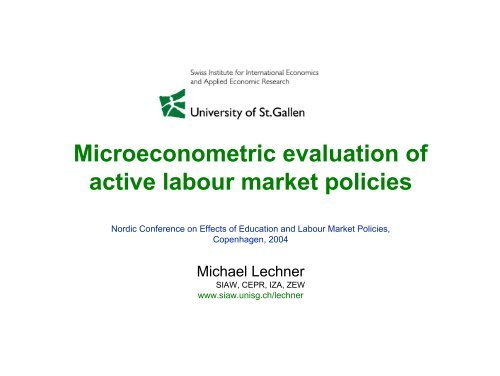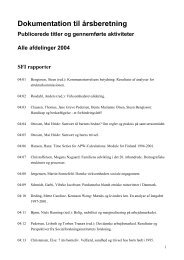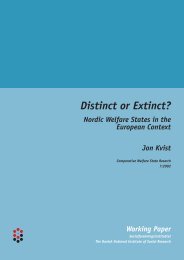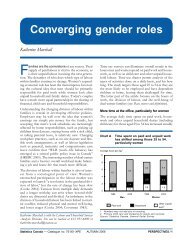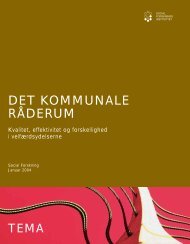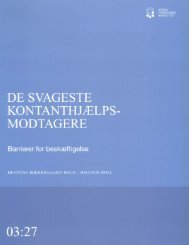Microeconometric evaluation of active labour market policies - SFI
Microeconometric evaluation of active labour market policies - SFI
Microeconometric evaluation of active labour market policies - SFI
Create successful ePaper yourself
Turn your PDF publications into a flip-book with our unique Google optimized e-Paper software.
<strong>Microeconometric</strong> <strong>evaluation</strong> <strong>of</strong><br />
<strong>active</strong> <strong>labour</strong> <strong>market</strong> <strong>policies</strong><br />
Nordic Conference on Effects <strong>of</strong> Education and Labour Market Policies,<br />
Copenhagen, 2004<br />
Michael Lechner<br />
SIAW, CEPR, IZA, ZEW<br />
www.siaw.unisg.ch/lechner
Structure <strong>of</strong> talk<br />
Part: 0: The identification problem<br />
Part I: 4 types <strong>of</strong> papers on the effects <strong>of</strong> ALMP in CH<br />
- different methods<br />
- different data<br />
- different questions<br />
Part II: Overview <strong>of</strong> econometric estimators used for <strong>evaluation</strong>
Introduction to selection bias and causal effects<br />
Many microeconometric <strong>evaluation</strong> studies <strong>of</strong> <strong>active</strong> <strong>labour</strong> <strong>market</strong> <strong>policies</strong> in<br />
Europe (e.g. ‘old’ survey by Heckman, LaLonde, Smith, 1998, Handbook <strong>of</strong><br />
Labour Economics, 4)<br />
Problems <strong>of</strong> all studies<br />
– Case workers select specific types <strong>of</strong> unemployed into specific programmes<br />
– Specific unemployed self-select into specific programmes<br />
– Programmes may have effect on <strong>labour</strong> <strong>market</strong> outcomes<br />
Labour <strong>market</strong> outcomes are correlated with participation, but why?<br />
How can we disentangle selection and programme effects?
The identification problem<br />
– Nonparticipants may not be comparable to participants<br />
– Participants before participation may not be comparable to participants after<br />
participation<br />
– These problems might persist even after conditioning on observable attributes<br />
Bad news: required assumptions are untestable!<br />
Even worse: different identifying strategies identify different effects!<br />
Important first steps in every <strong>evaluation</strong> study:<br />
- What do we want to estimate?<br />
- How can we translate desired effect into a statistical causal parameter?<br />
- What do we need to know to be able to estimate this parameter?
Three solutions to the identification problem with<br />
heterogeneous effects<br />
– Postulate parametric model for the dependence <strong>of</strong> the outcome variable on<br />
selection and programme effects, restrict effect heterogeneity<br />
- typically hard to justify by economic reasoning<br />
– Compare participants and nonparticipants that are identical for all<br />
characteristics related to outcomes and participation (CIA; Rubin, 1974)<br />
* confounders observed; instrument must exist, but is unobserved<br />
+ nonparametric; justifiable by economic, institutional reasoning;<br />
- very large and informative data necessary<br />
– Find variable which affects outcomes only because it affects the<br />
participation decision (IV, Imbens, Angrist, 1994, Heckman, 1978)<br />
* instrument observed; some confounders unobserved<br />
- average effect generally not identified<br />
All nonparametric identification strategies<br />
and related estimators belong to B or C!<br />
(e.g. Vytlacil, 2002)
Credibility <strong>of</strong> identification strategies<br />
– Depends on economic context (institutions, behaviour)<br />
– Data<br />
⇒ Get to know the context and the data first !
Switzerland provides an interesting example<br />
– Active <strong>labour</strong> <strong>market</strong> policy<br />
– Very good data<br />
– Similar to other OECD countries<br />
– Special: Considerable regional autonomy<br />
– Special: Low level <strong>of</strong> unemployment
Switzerland and her 26 cantons
Expenditures in an international comparison<br />
USA<br />
Japan<br />
Korea<br />
Hungary<br />
UK<br />
Norw ay<br />
Italy<br />
Canada<br />
Sw itzerland<br />
Australia<br />
Austria<br />
Spain<br />
France<br />
Sw eden<br />
Germany<br />
Finland<br />
Belgium<br />
Netherlands<br />
Expenditures for <strong>labour</strong> <strong>market</strong> policy<br />
1999 in % <strong>of</strong> GDP<br />
0 1 2 3 4<br />
Passive measures<br />
Active measures<br />
source: OECD Employ ment Outlook 2003
Active <strong>labour</strong> <strong>market</strong> policy in Switzerland<br />
Considerable <strong>active</strong> <strong>labour</strong> <strong>market</strong> <strong>policies</strong><br />
Expenditures for <strong>labour</strong> <strong>market</strong> <strong>policies</strong> in Switzerland (millions CHF)<br />
6'000.0<br />
5'000.0<br />
4'000.0<br />
3'000.0<br />
2'000.0<br />
1'000.0<br />
-<br />
1990 1995 1997 1998 1999 2000 2001<br />
passive measures<br />
Active measures
Cantonal variation in unemployment<br />
Unemployment rates October 2003 by canton
- ORGANISATION <strong>of</strong> <strong>active</strong> <strong>labour</strong> <strong>market</strong> policy (ALMP)<br />
Legislative authority: confederation.<br />
Execution and implementation: cantonal<br />
1997 / 1998 confederation wanted to make sure that cantons allocate many<br />
UE into (new) programmes:<br />
cantons which fill less than the required minimum number <strong>of</strong> year-places have to<br />
compensate the federal unemployment insurance funds with 20% <strong>of</strong> the unemployment<br />
benefits payments to those persons to whom no ALMP could be <strong>of</strong>fered<br />
– DESIGN <strong>of</strong> ALMP<br />
- counselling, placement services<br />
- training programmes and courses<br />
- employment programmes<br />
- subsidised interim jobs<br />
- …<br />
– RULES <strong>of</strong> ALMP<br />
Willingness to participate is condition for receiving UE benefits<br />
Caseworkers decide about participation
Data<br />
Individual administrative records from unemployment<br />
insurance system and social security (1988-1999)<br />
identify outcomes, treatment status, region (municipality),<br />
regional employment <strong>of</strong>fice in charge<br />
Valuable individual information (proxies for motivation, etc.)<br />
Regional information, commuting distances<br />
identify local <strong>labour</strong> <strong>market</strong>s which have at least two parts<br />
belonging to different administrative regions (cantons)
Structure <strong>of</strong> the discussion <strong>of</strong> empirical papers<br />
A. What parameters do we want to know?<br />
B. How do we identify them?<br />
C. How do we estimate them?<br />
D. What do we find?
Gerfin, Lechner (2002): <strong>Microeconometric</strong> Evaluation <strong>of</strong> Active<br />
Labour Market Polices in Switzerland, Economic Journal<br />
Gerfin, Lechner, Steiger (2003): Does subsidised temporary<br />
employment get the unemployed back to work? An econometric<br />
analysis <strong>of</strong> two different schemes, DP<br />
A. What do we want to know ?<br />
– Mean <strong>of</strong> effects <strong>of</strong> programmes for participants and nonparticipants<br />
– Comparison <strong>of</strong> effects <strong>of</strong> different subprogrammes<br />
– Mean effects for broad subgroups defined on observables<br />
ATE, ATET, NATET (in subgroups)
Gerfin, Lechner (2002), Gerfin, Lechner, Steiger (2003)<br />
B. How do we identify pairwise ATEs and ATETs?<br />
Using good data to form comparison groups identical in all characteristics<br />
influencing outcome and participation<br />
(CIA: conditional independence assumption)<br />
- <strong>labour</strong> <strong>market</strong> history over 10 years<br />
- very detailed information about job before UE<br />
- subject valuations <strong>of</strong> case workers<br />
Still enough variation left - most likely unrelated to outcomes
Gerfin, Lechner (2002), Gerfin, Lechner, Steiger (2003)<br />
C. How do we estimate pairwise ATEs and ATETs?<br />
Matching on the propensity score on common support<br />
(as in Lechner, 2002, REStat)<br />
+ Simple and robust<br />
- Not asymptotically efficient
Gerfin, Lechner (2002), Gerfin, Lechner, Steiger (2003)<br />
D. What do we find?<br />
ATET, ATE:<br />
? Training not clear<br />
+ Subsidised temporary jobs<br />
- Employment programmes<br />
Other findings:<br />
- Mean effects vary not much with participation status<br />
+ Bad risks may have a positive effect from a employment programme
Gerfin, Lechner (2002), Gerfin, Lechner, Steiger (2003)<br />
Average effects for the population: A comparison to nonparticipation<br />
A typical shape when programme duration is part <strong>of</strong> the effect
Gerfin, Lechner (2002), Gerfin, Lechner, Steiger (2003)<br />
Average effects for the TEMP: A comparison to TEMP
Lechner, Smith (2003): What is the value added <strong>of</strong> case workers?,<br />
DP<br />
Frölich, Lechner, Steiger (2003): Statistically aided programme<br />
selection, mimeo.<br />
Ideas: I. Are case workers effective in programme selection?<br />
II. If not, we help them by giving them our results ☺<br />
A. What do we want to know ?<br />
– Mean <strong>of</strong> effects <strong>of</strong> programmes for participants and nonparticipants for<br />
different subgroups based on observables<br />
– Comparison <strong>of</strong> effects <strong>of</strong> different subprogrammes<br />
– Mean effects for broad subgroups defined on observables<br />
ATE in small subgroups for predicting future outcomes
Lechner, Smith (2003), Frölich, Lechner, Steiger (2003) - SAPS<br />
B. Identification? CIA as before<br />
C. Estimation:<br />
– Problem: Nonparametric estimates too imprecise in small cells<br />
– (Semi-) parametric estimators based on the propensity score<br />
– Results<br />
- case workers as effective as random number generators <br />
- considerable improvement possible if case workers use information about<br />
effect heterogeneity coming from a system based on ‘individual’ predictions<br />
<strong>of</strong> outcomes <strong>of</strong> different programmes<br />
SAPS<br />
statistically aided programme selection
Frölich, Lechner (2003): Regional treatment intensity<br />
as instrument for the <strong>evaluation</strong> <strong>of</strong> <strong>active</strong> <strong>labour</strong> <strong>market</strong> <strong>policies</strong><br />
Idea<br />
Use arbitrariness <strong>of</strong> regional boarders, regional autonomy and a ‘strange’<br />
incentive introduced by the Swiss federal government as an instrument<br />
A. What do we want to know ?<br />
– Mean effects <strong>of</strong> programmes<br />
– Can estimate what we want to know only for subpopulation re<strong>active</strong> to<br />
changes in instrument (compliers LATE, marginal effect)<br />
– Note 1: Different instruments estimate may estimate different quantities<br />
– Note 2: Some <strong>of</strong> those quantities are not interesting at all
Frölich, Lechner (2003) – regional IV<br />
B. How do we identify LATEs?<br />
– suppose people locate randomly in different parts <strong>of</strong> a region<br />
– suppose this region constitutes one integrated <strong>labour</strong> <strong>market</strong> with two treatment regimes<br />
– suppose that once being unemployed, the probability <strong>of</strong> participation in ALMP differs according to<br />
specific part <strong>of</strong> region the UE is living<br />
Living in a specific part <strong>of</strong> the region impacts participation probability, but has no impact on <strong>labour</strong><br />
<strong>market</strong> outcomes in the absence <strong>of</strong> participation<br />
Location in region is a candidate for an INSTRUMENT!<br />
Estimates mean effect for those who would change participation status if faced with different<br />
participation probability (complier)!
Frölich, Lechner (2003) – regional IV<br />
Integrated local <strong>labour</strong> <strong>market</strong>s<br />
– About 170 regional employment <strong>of</strong>fices (REO) in 1998<br />
– definition <strong>of</strong> local <strong>labour</strong> <strong>market</strong>: Cluster <strong>of</strong> REO<br />
– spread over 2 cantons<br />
– commuting times between REO < 30 minutes (by car)<br />
– same language (French, German or Italian)<br />
– composition <strong>of</strong> ALMP is similar in REO on both sides<br />
→ 30 integrated <strong>labour</strong> <strong>market</strong>s identified
Frölich, Lechner (2003) – regional IV<br />
Conditions for valid exclusion restriction<br />
A. Regional treatment intention (RTI) does not affect non-treated<br />
and treated employment chances<br />
B. RTI is independent <strong>of</strong> employability <strong>of</strong> local population<br />
Conditions to estimate a mean causal effect for compliers<br />
C. RTI is independent <strong>of</strong> type-composition <strong>of</strong> local population<br />
D. Size <strong>of</strong> defier population is zero<br />
E. Size <strong>of</strong> complier population is positive
Frölich, Lechner (2003) – regional IV<br />
C. Estimation<br />
Variation in participation due to diff‘s in quota is small weak instrument problem<br />
1) Estimate LATE‘s for every pair <strong>of</strong> regions within the same local <strong>labour</strong> <strong>market</strong> <br />
30 noisy estimates --> aggregate!<br />
[ = ] − [ = ]<br />
[ | ''] [ | ']<br />
1 0<br />
EY| Z z'' EY| Z z'<br />
E⎡<br />
⎣Y −Y | Τ= c⎤<br />
⎦ =<br />
E D Z = z − E D Z = z<br />
instrument weak denominator small<br />
Wald (IV, 2SLS, LIML, …) estimator has bad small sample properties<br />
1<br />
Use fuller estimators instead: ˆ α<br />
−<br />
θ = ⎡ '( (1 − ) + ) ⎤ '( (1 − ) + )<br />
⎣D I k kP D ⎦ D I k kP Y<br />
' −1 '<br />
PN = ZN( ZNZN)<br />
Z<br />
α<br />
N k = k LIML<br />
−<br />
N − L<br />
N N N N N N N N
Frölich, Lechner (2003)-IV<br />
D. Empirical results: Regions with similar ALMP<br />
Employment (in%-points) High earnings (in %-p.)<br />
May ‘98 Sept May Sept.’98<br />
Effect 9.5 8.3 13.2 10.4<br />
Std. error 7.1 7.0 7.0 7.3<br />
t-value 1.33 1.19 1.88 1.43<br />
Bootstrapped t-distribution<br />
Q 0.95<br />
1.29 1.47 1.13 1.23<br />
Q 0.975<br />
1.60 1.72 1.35 1.59<br />
Q 0.995<br />
1.98 2.26 1.67 2.22
Lechner, Miquel (2001): Identification <strong>of</strong> dynamic effects, DP<br />
Lechner (2004): Dynamic matching, DP University <strong>of</strong> St. Gallen<br />
Miquel (2003a): Dynamic diff-in-diff, DP University <strong>of</strong> St. Gallen<br />
Miquel (2003b): Dynamic IV, DP University <strong>of</strong> St. Gallen<br />
Idea <strong>of</strong> I and II: Interest is in effects <strong>of</strong> sequences <strong>of</strong> treatment when data is good<br />
enough to control for sequential selection biases<br />
Idea <strong>of</strong> III and IV: Instruments<br />
A. What do we want to know and what is the problem?<br />
– Mean effects <strong>of</strong> sequences <strong>of</strong> programme participation (DATE, DATET)<br />
– Sequential selection<br />
– Selection may be based on endogenous variables (intermediate outcomes)
Lechner, Miquel (2003), Lechner (2003) - dynamics<br />
B. Identification?<br />
– DCIA, weak and strong versions depending on how selection process works<br />
– W-DCIA does identify DATE, but not all DATET<br />
– Estimation<br />
- Sequential matching<br />
D. Results<br />
- not yet to be presented
Part II:<br />
Standard estimators used in policy <strong>evaluation</strong><br />
OLS, GLS, Probit, Duration models etc.<br />
- CIA combined with functional form assumptions<br />
- effect homogeneity<br />
- need very informative data for CIA to hold<br />
Matching (many ways to do it)<br />
- nonparametric version <strong>of</strong> above; CIA<br />
- need very informative and large data
Part II: Standard estimators used in policy <strong>evaluation</strong><br />
Linear IV (SLS. etc.)<br />
- exploits exclusion restriction combined with functional form<br />
- effect homogeneity<br />
Nonparametric IV with discrete instruments<br />
- no functional form necessary<br />
- exclusion restriction <strong>of</strong>ten hard to justify<br />
- instruments may <strong>of</strong>ten be weak<br />
- only LATE is identified
Part II: Standard estimators used in policy <strong>evaluation</strong><br />
Before-after, difference in difference, fixed effects, etc.<br />
- exploits information for the participants before participation<br />
- exploits information for the nonparticipants before and after participation<br />
- effect homogeneity (within: strict exogeneity)<br />
- even ‘nonparametric’ version requires functional form assumptions (e.g. required<br />
assumption may hold in levels but not in log’s etc.)<br />
- having a panel to analyse does not mean that typical panel estimators must be used<br />
(matching or standard IV may be superior)<br />
Control function estimators (Heckit, other model with ‘unobserved<br />
heterogeneity’)<br />
- nonparametric version identical to IV (+functional forms)<br />
- even parametric version needs exclusion restriction to produce stable estimates
Part II: Standard estimators used in policy <strong>evaluation</strong><br />
Regression discontinuity design<br />
- useful in cases when all are subject to some policy once a threshold is passed<br />
no ready comparison groups, because no support<br />
- local IV (passing threshold has no effect!)<br />
- local LATE<br />
Every other econometric estimator technique has an interpretation<br />
as an estimator for causal effects<br />
But: Implicit conditions for identification <strong>of</strong> causal effects must be derived. Causal effect<br />
may not be readily seen by looking at coefficient.<br />
Structural modelling<br />
Partial equilibrium economic choice models<br />
CGE’s<br />
Again: Are the underlying assumptions plausible? What are the economic / behavioural<br />
restrictions implied by ‘statistical assumptions’?
Are some methods magic bullets ?<br />
Important issues in performing an <strong>evaluation</strong> study:<br />
– Know the selection mechanism and how the programmes are run<br />
– Derive restrictions from the selection mechanism<br />
– Data collection: Case 1 - you have no influence on data collection:<br />
- given the data available, is there a plausible identification strategy?<br />
- if so, are there enough observations to use a nonparametric estimator?<br />
- would a structural modelling approach be plausible?<br />
– Data collection: Case 2 – you have influence on the data collection:<br />
- make sure the data is collected such that reasonable identification<br />
strategy becomes feasible<br />
- make sure sample is large enough so that nonparametric estimation<br />
methods can be used
Are some methods magic bullets ?<br />
The merits <strong>of</strong> any <strong>of</strong> the discussed <strong>evaluation</strong><br />
strategies depends entirely on the institutional<br />
background, on the behaviour <strong>of</strong> the agents in the<br />
selection and outcome processes, and on the data<br />
available.<br />
There is no <strong>evaluation</strong> method that<br />
is superior in all circumstances!


